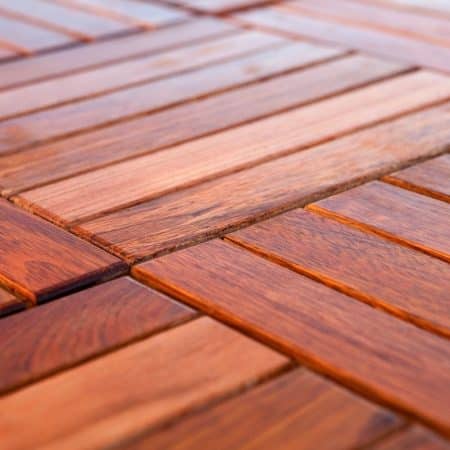BETTERWOOD " ADVICE » WOOD TILES " EMBARRASSED
Lay wooden tiles
Laying the wooden tiles with the plug-in system is relatively easy. If you follow the instructions below, you will achieve excellent results in a short time.
laying pattern
The wooden tiles from Betterwood are made of tropical wood of the highest durability (resistance class 1) and measure 30x30cm. The plastic grid of the substructure allows laying in two variants: parallel or in a checkerboard.



Substrate:
- Lay the tiles on one solid and level ground that dries well and water drainage is guaranteed. Concrete, concrete tiles, ceramic tiles, screed flooring, asphalt or the like are suitable for this, for example. We advise against laying on building protection mats, as these can store water.
- The ground should have a slight incline for the rainwater runoff exhibit. Each tile stands on over 50 short legs that prevent water blocking through the wooden tiles.
- If you want to lay on an uneven or soft surface (e.g. lawn), you should cover the surface with a ca. six-inch thick Gravel layer pour in a grain size of 0/45. Make sure there is good water drainage here too.
Installation
- The tiles come with the built-in plug-in system simply connected at the bottom. No tools are required for this.
- If necessary, you can lay the tiles lengthways and across the wooden slats crop. You can cut the plastic substructure and wooden slats with a hand-held circular saw. Here is a detailed guide on how to Cutting wooden tiles.
- Screws may need to be tightened or replaced. When cutting, you should make sure that the screws are moved if necessary.
- The wooden tiles should not be firmly attached to the subsoil in order to be able to swell and shrink with the changing weather conditions.
- You should keep a minimum distance of 10-15mm to solid structures such as walls and doorsteps.

Our wooden tiles
6,50 €
Cumaru wood tiles, FSC 100%
Price: €72 per m2, resistance class: 1
Advantages: ✓ best durability ✓ particularly robust and scratch-resistant
Disadvantages: ✗ partly rough surface
Tip:Sand tiles after initial exposure to weather.
6,50 €
Garapa wood tiles, FSC 100%
Price: €72 per m2, resistance class: 1-2
Advantages: ✓ smooth surface ✓ homogeneous, light color
Disadvantages: ✗ Ferrous substances lead to discolouration
Tip: Patio cleaning removes discoloration
6,50 €
Jatoba wood tiles, FSC 100%
Price from: €72 per m2, resistance class: 1-2
Advantages: ✓ smooth surface ✓ strong color and grain
Disadvantages:✗ unoiled tendency to crack ✗ colored ingredients wash out
Tip:Clean and oil tiles after installation.
7,50 €
Teak wood tiles, FSC 100%
Price: €83 per m2, resistance class: 1
Advantages:✓ Best durability and dimensional stability ✓ Lowest risk of cracks and splinters
Disadvantages: ✗ slightly more expensive
Tip: Terrace oil is not necessary if silvering is desired.











